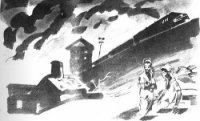Operation Nemesis: The Assassination Plot that Avenged the Armenian Genocide - Bogosian Eric (мир книг .txt) 📗
In almost every valley there were some bodies and in several of them a great many,—in one, at least a thousand; in another I estimated that there were more than fifteen hundred, but the stench from them was so great that, although I tried to go up in the end of the valley, I was unable to do so at the time. I explored it more carefully a month later. This valley, like many of the others, was triangular in shape and shut in on two sides by high precipitous banks which the people when attacked were not able to climb. Two or three gendarmes stationed on each side could prevent a multitude from escaping in that way. Many bodies lay wedged among the rocks at the extreme end of the valley, showing that some had tried in vain to scale them in their attempt to escape and had been killed there.… Thus the victims were literally penned in and butchered in cold blood. The bodies were piled on top of one another and had apparently been there between two and three weeks.
A collection of American consular reports runs to over six hundred pages.21 These reports are congruent with the reports by German, British, and French observers. Turkish deniers of the genocide argue that the reports were made by American missionaries and diplomats and so are unreliable. The implication is that Americans were on the “other side” by the end of the war (although the United States never declared war on Turkey), so the reports must be biased. Reports by the Turks’ German allies, however, confirm rather than refute the missionary and consular reports.
The Ottoman Empire threw its lot in with Germany during the war. Hundreds of German officers were stationed in Anatolia. The asymmetric relationship between Germany and the Ottoman Empire as allies was complex and was not always fully embraced by either high-level Germans or Turks. Nevertheless, owing to the machinations of hawks on both sides, the alliance thrived. This meant that Germany and German officers must have been aware of, or in some way a party to, Muslim actions against Christians in the Ottoman Empire. How Germany aided and abetted the genocide has been debated for years. But without doubt, German diplomats knew that bad things were happening to the Armenians.
Wolfgang Gust has collected a massive archive of German documents in his Volkermord an den Armeniern 1915/16 (The Armenian Genocide: Evidence from the German Foreign Office Archives, 1915–1916). The archive consists of six hundred pages of German testimony regarding the genocide. General Otto Liman von Sanders, who testified at Tehlirian’s trial, addresses the deportation of the Armenians in Smyrna: “It was confirmed to me that several hundred Armenians had been arrested by the police—partly in the roughest manner, by fetching old women and sick children out of their beds in the night—and had been taken straight to the train station. Two trains full of Armenians had been transported away.”22
Heinrich Vierbucher, who was Liman von Sanders’s interpreter during the war, visited much of the territory and was able to make objective observations. In the book Armenia 1915, this German national reports on what he learned through official sources:
The teachers of the American school in Kharpert were gruesomely tortured before they were killed. Professors Tenekejian and Bujiganian had their hair and beards ripped out while in prison in order to extort confessions, and were hung by their hands for days at a time. Another professor went insane when he was forced to watch Armenians being beaten to death. The vali himself took part in the torture of Professor Lulejian. The senior executive president beat him until he was exhausted and said, “Whoever loves his religion and his people, may he continue beating.”
In Diyabekir the same procedure was followed as in Trabizond. Twenty-six prominent Armenians, among them the priest of Alpiar, were first murdered in prison; the priest’s young wife was raped by ten policemen and almost humiliated to death. Then 674 men were loaded onto rafts, and thrown overboard in the Euphrates and shot by the policemen. Five priests were stripped and tarred, and led through the streets of Diyarbakir. A noncommissioned officer boasted that along with five policemen he had shot to death seven hundred defenseless Armenians on the road from Diyarbakir to Urfa. The district administrator of Lijeh, who did not comply with a verbal order from the vali to mow down the Armenians, was removed from office and murdered on the way to Diyarbakir.
In the vicinity of Sasun three thousand men were deported to Kharpert and with the exception of three persons, were slaughtered.23
Lieutenant Colonel Stange, a German officer stationed in Erzerum, states: “The Armenians from Erzindjan were all driven together into the Kamakh gorge (Euphrates) and massacred there. There are fairly credible reports that the bodies were loaded onto carts which had already been placed there in preparation, and driven to the Euphrates and then thrown into the river.”24 Vice Consul Walter Holstein reports from Der Zor, “The misery of these people is indescribable; women and children are dying of hunger every day; their clothes decay on their bodies.”25
The German consul, Wilhelm Litten, traveled from Baghdad to Aleppo, in the direction opposite to the deportation trains. He describes the scene along the route:
Beyond Der Zor began the Trail of Horror.… I no longer needed to guess the individual fates but had to behold the misery with my own eyes: a large transport of Armenians passed me by just beyond Sabha, driven by the gendarmerie guards to walk faster and faster, and then the whole misery of the stragglers became apparent in live form. I saw by the wayside hungry, thirsting, sick, dying, freshly deceased, mourning beside fresh bodies, and those who could not part quickly enough from their relatives endangered their own lives, because the next station or oasis was three days march away for those on foot. Weakened by hunger, disease, pain they staggered on, fell, and lay still on the ground.… Not until I was between Meskene and Aleppo did I see no more Armenians and no more bodies since the transports did not touch Aleppo at all, but were re-routed via Bab.26
The issue of German complicity is one that is argued to this day. Liman von Sanders was explicit in his court testimony that Germany did not take orders from Turkey and committed no atrocities or massacres. More recently, in a 2005 interview, Hilmar Kaiser, a German historian who specializes in the Armenian Genocide, stated, “The complicity of the Germans in the Armenian Genocide is a political invention and does not withstand scrutiny.”27
Yet historian Vahakn Dadrian insists: “By explicit and strict orders from the German High Command in Berlin, the multitudes of German officers affiliated with the Germany Military Mission to Turkey were forbidden to intervene in the process of the extermination of the Armenian population of the empire.”28 (A footnote to the topic of German complicity: hundreds of Germans fought in the Ottoman Empire during World War I, including a man who would become one of Adolf Hitler’s best friends, Max Erwin von Scheubner-Richter. Many of these German soldiers would later serve as SS officers during World War II.)
Dadrian quotes one soldier: “Turkish officers and gendarmes each evening were picking out dozens of Armenian men from the ranks of the deportees and were using them as targets for practice games.” As a Turk who served in the army explained after the war, “They were going to die anyway.”29 Among the many German witnesses was Armin Wegner, who backed up his reporting with photography. He would become an ardent friend of the Armenians after the war, as would a number of fellow Germans who witnessed the atrocities.




